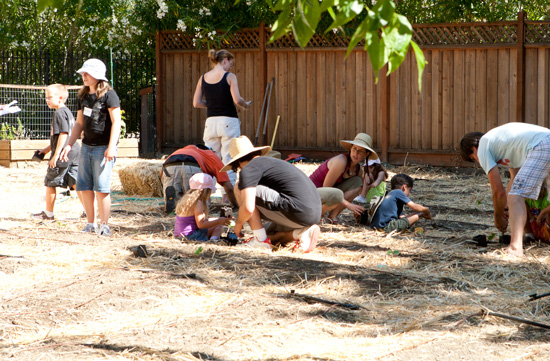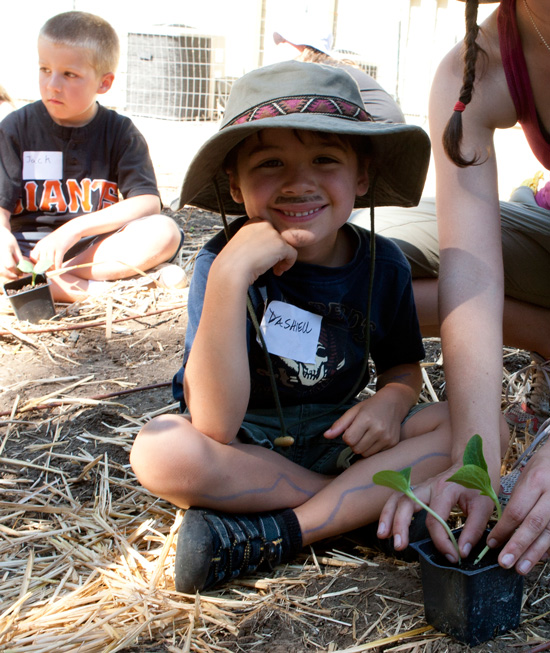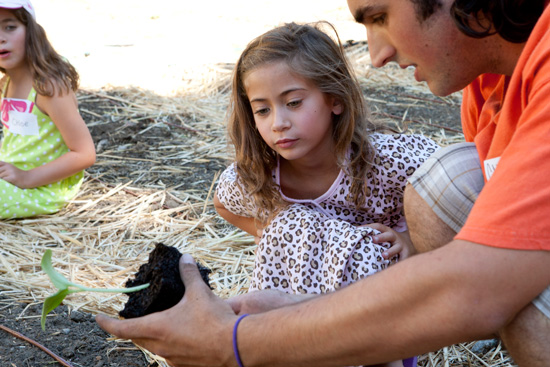| | Published July 21st, 2010
| Growing Like Weeds - Or Pumpkins
| | By Sophie Braccini |  | | The Urban Farmers and friends at work in a Lafayette garden (intern Chelsea O'Sullivan in big hat and purple top) Photos Doug Kohen
|
"What comes out of a seed?" asks Chelsea O'Sullivan, a Saint Mary's College student on a summer internship with the non-profit organization Urban Farmers; gathered around her is a collection of very young farmers. On the other side of this Reliez Valley garden Cameron Sioshansi, co-founder of Urban Farmers, stands atop a compost pile explaining to a slightly older group - those over age five - the role of this important element for the natural fertilization of the soil. What will come out of a seed as a result of the day's activities? A burgeoning community pumpkin patch which, come October, will reward the hard work of little farmers with their very own home-grown jack-o'-lanterns.
 On several mornings leading up to last weekend, six-year old Jessica and three-year old Paulo Delia awakened at 5:45 a.m. to ask their mother, Jennifer, "Is it planting pumpkin day today?" The Delia family of Lafayette is one of 20 participating homeowners with large yards, turned urban farming fields, who have enabled a new project: The creation of a farm that's divided between a number of private properties, each giving a portion of their land to the project in exchange for a share of the produce. Each plot is dedicated to one or two crops; the harvest will be shared among the land providers and the extra will either be given to those in need or sold at farmers' markets. The structure allows for the inclusion of the community in events such as the pumpkin patch.
On several mornings leading up to last weekend, six-year old Jessica and three-year old Paulo Delia awakened at 5:45 a.m. to ask their mother, Jennifer, "Is it planting pumpkin day today?" The Delia family of Lafayette is one of 20 participating homeowners with large yards, turned urban farming fields, who have enabled a new project: The creation of a farm that's divided between a number of private properties, each giving a portion of their land to the project in exchange for a share of the produce. Each plot is dedicated to one or two crops; the harvest will be shared among the land providers and the extra will either be given to those in need or sold at farmers' markets. The structure allows for the inclusion of the community in events such as the pumpkin patch.
 The Delias' home in the Reliez Valley area of Lafayette was selected by Urban Farmers for the establishment of the pumpkin patch. "When Siamack (Sioshansi) asked us if we could dedicate our area to creating a pumpkin patch I thought it was a good idea," said Jennifer Delia, "we have a portion of our lot that's flat and that we didn't want to landscape; turning it into a vegetable garden is the best idea, and a pumpkin patch is a great activity that brings parents and children together." Delia values the fact that her children are learning where pumpkins come from and will participate in the whole growing process.
The Delias' home in the Reliez Valley area of Lafayette was selected by Urban Farmers for the establishment of the pumpkin patch. "When Siamack (Sioshansi) asked us if we could dedicate our area to creating a pumpkin patch I thought it was a good idea," said Jennifer Delia, "we have a portion of our lot that's flat and that we didn't want to landscape; turning it into a vegetable garden is the best idea, and a pumpkin patch is a great activity that brings parents and children together." Delia values the fact that her children are learning where pumpkins come from and will participate in the whole growing process.
 Over 30 families participated in the planting of the pumpkin patch. They were asked to contribute $25 to cover the expense and come to Reliez Valley on July 16th or 17th so the children could plant their pumpkins. The process was simple and fun. Kids were first asked to draw a sign that would mark the location of their buried seed; then they were divided in two groups, 3-5 year olds and 5-and-over, and given an age-appropriate education in pumpkin farming.
Over 30 families participated in the planting of the pumpkin patch. They were asked to contribute $25 to cover the expense and come to Reliez Valley on July 16th or 17th so the children could plant their pumpkins. The process was simple and fun. Kids were first asked to draw a sign that would mark the location of their buried seed; then they were divided in two groups, 3-5 year olds and 5-and-over, and given an age-appropriate education in pumpkin farming.
 Then each child chose a spot in the pre-prepared raised beds, dug a little hole and planted his or her pumpkin seed "with the pointy side up," as farmer Chelsea explains. Each child staked her claim with a lollipop stick bearing her name. If anything, they were surprised at how fast and easy it was to plant a pumpkin. They added a few seedlings that had been started in small containers, and will later compare the different rates of growth. Additional seeds were added to the patch in case any of the kids' plants don't survive.
Then each child chose a spot in the pre-prepared raised beds, dug a little hole and planted his or her pumpkin seed "with the pointy side up," as farmer Chelsea explains. Each child staked her claim with a lollipop stick bearing her name. If anything, they were surprised at how fast and easy it was to plant a pumpkin. They added a few seedlings that had been started in small containers, and will later compare the different rates of growth. Additional seeds were added to the patch in case any of the kids' plants don't survive.
 "It is a great idea," said Paulie Profett-Fabela as her son was completing his planting. "Every year we grow some vegetables in our garden, but we had never done pumpkins before; this is a great way to learn."
"It is a great idea," said Paulie Profett-Fabela as her son was completing his planting. "Every year we grow some vegetables in our garden, but we had never done pumpkins before; this is a great way to learn."
 The children were invited to return to the patch regularly to tend to the plants and see the pumpkins grow. "We recommend that children come back every week or every other week," Sioshansi said to the parents, "we have prepared a curriculum of activities for them to learn about the natural growing process."
The children were invited to return to the patch regularly to tend to the plants and see the pumpkins grow. "We recommend that children come back every week or every other week," Sioshansi said to the parents, "we have prepared a curriculum of activities for them to learn about the natural growing process."
 "I believe that it is very important to teach the kids where our food comes from," said Jenny Rosen, another participating homeowner whose daughter, Hannah, helped with the creation of the individual signs. "Most important to me is to teach children all the elements that go into growing food. They will see the time it takes, and what's needed besides the seed itself. It will give them a lot to think about."
"I believe that it is very important to teach the kids where our food comes from," said Jenny Rosen, another participating homeowner whose daughter, Hannah, helped with the creation of the individual signs. "Most important to me is to teach children all the elements that go into growing food. They will see the time it takes, and what's needed besides the seed itself. It will give them a lot to think about."
 For more information about the Urban Farmers and their projects go to www.theurbanfarmers.org. For more information about the Urban Farmers and their projects go to www.theurbanfarmers.org.

|
 | | Dashiell Fabela (age 6)
|  | | Cameron Sioshansi helps Francesca Delia with a seedling
| | | | | | | | | Advertisement | | |
| | | | | | Comments | | | | | |  | | |
| | |  | | |
| | | | |






